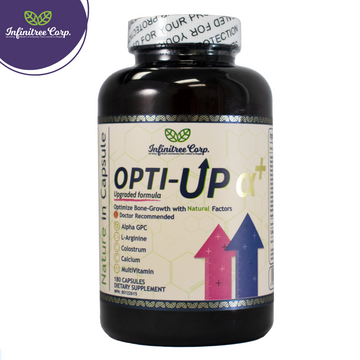
Do Growth Plates Close Earlier in Athletes?
InfinitreeEditor.Jo
“He’s Stronger Than Ever, But Not Taller”
Ryan, age 13, had been training in competitive gymnastics since he was six. He was agile, disciplined, and physically fit beyond his years. But by the time he turned 14, his growth chart showed a concerning trend—he hadn’t grown in height for nearly a year.
His parents began to worry. Could all the intense training have caused his growth plates to close early?
It’s a common fear among parents of young athletes:
“Is my child’s sport helping or hurting their growth?”
Let’s explore the truth.
What Are Growth Plates, and Why Do They Matter?
Growth plates, or epiphyseal plates, are soft cartilage zones near the ends of long bones in children and teens. These are where bone growth in length occurs.
As a child matures, growth plates gradually:
-
Thicken and produce new bone tissue
-
Harden into solid bone
-
Eventually “close,” ending height increase
On average:
-
Girls' growth plates close around age 14–15
-
Boys' growth plates close around age 16–17
But various factors can accelerate or delay this closure.
Can Sports Cause Growth Plates to Close Early?
Here’s the short answer:
👉 Intense sports can influence growth—but not necessarily in a harmful way.
Growth plates don’t just snap shut because your child is athletic. But extreme stress, poor recovery, or injury can impact how they develop.
Let’s break down the key factors.
How High-Intensity Sports May Impact Growth Plates
🏋️ 1. Chronic Physical Stress
Training daily with little rest puts repetitive pressure on bones and joints. While this helps build strength and endurance, it may also:
-
Cause microtrauma around growth areas
-
Increase risk of inflammation or overuse injuries
-
Disrupt hormonal balance if the body doesn’t get enough recovery
Stress itself isn’t the enemy—lack of recovery is.
🤕 2. Growth Plate Injuries (Epiphyseal Injuries)
In sports like:
-
Gymnastics
-
Basketball
-
Soccer
-
Weightlifting
...kids may experience falls, joint stress, or repetitive impact. These can lead to:
-
Growth plate fractures
-
Inflammation around bone ends
-
Disrupted bone development
When not treated properly, these injuries may affect limb length or growth pace.
⚖️ 3. Energy Deficiency in High-Volume Training
Some athletes, especially in aesthetic or endurance sports (e.g., gymnastics, swimming, long-distance running), may not eat enough to match their energy output.
This leads to:
-
Low energy availability (LEA)
-
Hormonal imbalances
-
Delayed or disrupted puberty
Which may in turn affect the timing of growth plate closure.
What the Research (and Experience) Tells Us
Most moderate and even competitive athletic activity:
-
Supports healthy bone growth
-
Stimulates muscle development
-
Improves posture and coordination
However, without:
-
Proper nutrition
-
Adequate sleep
-
Rest periods
-
Injury prevention
...the risk of growth complications increases.
In short: It’s not the sport—it’s how the sport is managed.
Signs That Growth Plates Might Be at Risk
Watch for:
-
Persistent joint pain near knees, wrists, or ankles
-
Limping or unusual movement after exercise
-
Slowed or halted height gain (for 6+ months during puberty)
-
Unusual fatigue or low appetite
-
Recurrent overuse injuries
How to Keep Young Athletes Growing Safely
Let’s flip the question around: How can we ensure sports support height rather than hinder it?
✅ 1. Focus on Recovery, Not Just Training
For every hour of intense sport, kids need:
-
Hydration
-
Nutrient-dense meals
-
Rest (physical and mental)
-
Sleep (at least 9 hours)
💡 Recovery is when growth hormone kicks in—especially during sleep.
✅ 2. Balance High-Impact with Mobility
Add:
-
Stretching
-
Foam rolling
-
Yoga
-
Swimming
These decompress joints, protect cartilage, and keep bones mobile as they grow.
✅ 3. Prioritize Joint-Friendly Supplements
Use growth-focused formulas that support:
-
Bone density
-
Collagen production
-
Mineral absorption
Opti-Up Alpha Plus is ideal here, with:
-
✅ L-Arginine for natural growth hormone support
-
✅ Hydrolyzed Collagen for cartilage and joint strength
-
✅ Calcium + Vitamin D3 + Magnesium for skeletal growth
-
✅ Zinc + B Vitamins for recovery and metabolism
💡 Tip: Take after practice or with dinner to assist overnight repair.
✅ 4. Watch for Overtraining Red Flags
If your child:
-
Dreads practice
-
Seems withdrawn or overly tired
-
Complains of bone/joint pain
It may be time to reduce frequency or vary the intensity.
More isn’t always better—especially during puberty.
✅ 5. Communicate with Coaches and Healthcare Providers
Ask:
-
Is my child’s sport putting extra load on joints?
-
Are they rotating activities to reduce repetitive strain?
-
Can we add strength or flexibility sessions to balance their growth?
Your child’s growth timeline matters just as much as performance.
Sample Week: Growth-Safe Training for Teen Athletes
| Day | Activity | Focus |
|---|---|---|
| Monday | Team practice + 20 min stretch | Skill + joint decompression |
| Tuesday | Strength + light mobility | Bone loading + posture alignment |
| Wednesday | Rest + Opti-Up supplement | Recovery + hormonal support |
| Thursday | Game or high-intensity | Performance + mental focus |
| Friday | Yoga + protein-rich dinner | Flexibility + tissue repair |
| Saturday | Light practice + growth smoothie | Balance + nutrient intake |
| Sunday | Full rest + family walk | Hormonal reset + stress reduction |
Final Thoughts: Don’t Fear Sports—Manage Them Wisely
Sports aren’t the enemy of growth. In fact, they’re one of its greatest allies—when paired with rest, recovery, and proper nutrition.
So, do growth plates close earlier in athletes? Only if the body is overstressed, undernourished, or chronically injured.
But when managed well, athletic kids often grow stronger, taller, and more confident—on and off the field.
Support Athletic Growth with Opti-Up Alpha Plus
Formulated for active, growing kids:
-
✅ L-Arginine to trigger height potential
-
✅ Collagen to protect growth plates
-
✅ Calcium and Magnesium for bone development
-
✅ Vitamins for stamina and recovery
📦 Trusted by families. Made in Canada. 60-day supply.
Disclaimer: This article is for informational purposes only and does not constitute medical advice. Always consult your child’s doctor or sports therapist before making changes to training or supplements.




